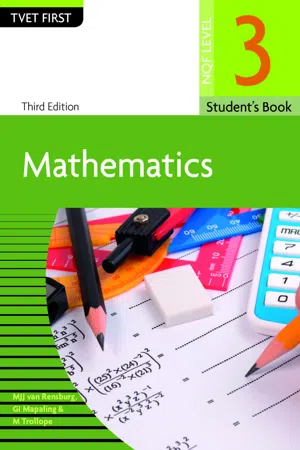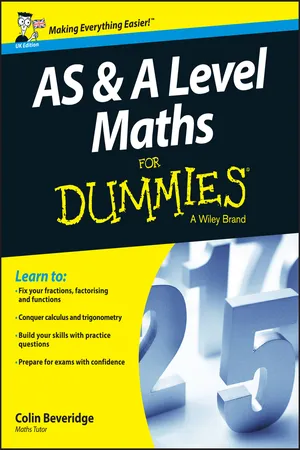Mathematics
Solving Trigonometric Equations
Solving trigonometric equations involves finding the values of the variables that satisfy the given trigonometric equation. This typically involves using trigonometric identities, solving for specific angles within a given range, and applying algebraic techniques to simplify and solve the equation. The solutions are often expressed in terms of exact values or as approximations using a calculator.
Written by Perlego with AI-assistance
Related key terms
1 of 5
8 Key excerpts on "Solving Trigonometric Equations"
- eBook - PDF
- Ron Larson(Author)
- 2021(Publication Date)
- Cengage Learning EMEA(Publisher)
©iStockphoto/MirasWonderland 362 Chapter 5 Analytic Trigonometry 1.4 Functions GO DIGITAL 5.3 Solving Trigonometric Equations Use standard algebraic techniques to solve trigonometric equations. Solve trigonometric equations of quadratic type. Solve trigonometric equations involving multiple angles. Use inverse trigonometric functions to solve trigonometric equations. Introduction To solve a trigonometric equation, use standard algebraic techniques (when possible) such as collecting like terms, extracting square roots, and factoring. Your preliminary goal in solving a trigonometric equation is to isolate the trigonometric function on one side of the equation. For example, to solve the equation 2 sin x = 1, divide each side by 2 to obtain sin x = 1 2 . - eBook - PDF
- Ron Larson(Author)
- 2021(Publication Date)
- Cengage Learning EMEA(Publisher)
©iStockphoto/MirasWonderland 522 Chapter 7 Analytic Trigonometry 1.4 Functions GO DIGITAL 7.3 Solving Trigonometric Equations Use standard algebraic techniques to solve trigonometric equations. Solve trigonometric equations of quadratic type. Solve trigonometric equations involving multiple angles. Use inverse trigonometric functions to solve trigonometric equations. Introduction To solve a trigonometric equation, use standard algebraic techniques (when possible) such as collecting like terms, extracting square roots, and factoring. Your preliminary goal in solving a trigonometric equation is to isolate the trigonometric function on one side of the equation. For example, to solve the equation 2 sin x = 1, divide each side by 2 to obtain sin x = 1 2 . - eBook - PDF
- Ron Larson(Author)
- 2017(Publication Date)
- Cengage Learning EMEA(Publisher)
2.3 Solving Trigonometric Equations 224 Chapter 2 Analytic Trigonometry Use standard algebraic techniques to solve trigonometric equations. Solve trigonometric equations of quadratic type. Solve trigonometric equations involving multiple angles. Use inverse trigonometric functions to solve trigonometric equations. Introduction To solve a trigonometric equation, use standard algebraic techniques (when possible) such as collecting like terms, extracting square roots, and factoring. Your preliminary goal in solving a trigonometric equation is to isolate the trigonometric function on one side of the equation. For example, to solve the equation 2 sin x = 1, divide each side by 2 to obtain sin x = 1 2 . - eBook - ePub
- Seymour B. Elk(Author)
- 2016(Publication Date)
- Bentham Science Publishers(Publisher)
On the other hand, using radian measurement, the formulations such as sin x 2, sin, [or even (x+1) sin x], etc. are readily viable. One can even allow “messy” functions such as sin(sin x), etc. without confusion or ambiguity. This is in direct contradistinction to traditional trig courses which allow the alternation of trig and arc trig functions, but disallow trg(trg x) or arctrg(arctrg x). For example, ; however, sin(tan) was undefined, since the tangent function had to be applied to an angle ONLY, rather than a number. Using dimensionless numbers (i.e., radians) on the other hand,. Probably the most important use of trigonometry involves the solution of triangles; namely, given three of the five independent components (namely all three of the sides and two of the angles. Remember that the third angle is NOT independent in plane trigonometry. This is in contradistinction to the trigonometry of a sphere wherein the three angles are independent. See Section 2.6 below). The simplest way to do this is to develop two important relations between a trig function of one or more of the angles along with some of the sides in a general triangle. These designated as the Law of Sines and the Law of Cosines are proved as follows: LAW OF SINES: From any vertex of a triangle, say C, draw the“altitude”(the line segment from the vertex perpendicular to the opposite side - extended if necessary). (See Fig. 2.4-6). Fig (2.4-6). Triangle Used to Derive the Laws of Sines and Cosines. Call this length h. Note that the sides a and b are the hypotenuses of respective right triangles and thus: Eliminating h using method #2 of Section 2.3. yields: LAW OF COSINES: Label the parts into which side c has been divided by drawing h above as: x and c−x - Boris Pritsker(Author)
- 2023(Publication Date)
- Chapman and Hall/CRC(Publisher)
6 Trigonometrical ExplorationsDOI: 10.1201/9781003359500-6Mathematics compares the most diverse phenomena and discovers the secret analogies that unite them.Joseph FourierTrigonometry is encountered in the most diverse problems of algebra, geometry, and calculus. It is a powerful and universal tool in getting links among math disciplines. There are numerous connections between them, expressed by trigonometric identities (you can find such identities in the appendix).In many cases trigonometry allows us to get appealing and efficient solutions compared to applications of pure geometrical or algebraic techniques. We will start with trigonometry “servicing” geometrical problems. PROBLEM 6.1. Of all the triangles with two sides of the given lengths, find the one with the greatest area.SOLUTION.There is no need even to make a diagram to solve this problem, as soon as we applied trigonometry. The area of a triangle can be determined by the formulaPROBLEM 6.2.S =, where a and b are the lengths of two sides, and γ is the angle between them. We know that1 2∙ a ∙ b ∙sin γfor any γ . Hence, the maximum area of a triangle will be attained forsin γ≤ 1, i.e., whensin γ= 1γ = 90 °, and it is. So, we conclude that of all the triangles with two sides of the given lengths the right triangle has the greatest area.S=m a x1 2∙ a ∙ bIn a right triangle, the hypotenuse is c and one of its acute-angle bisectors is. Find the legs.c 33SOLUTION.In the right triangle ABC (One of the possible approaches to this problem is applying algebraic techniques setting up a system of equations. Let’s see where it would get us.∠ A C B = 90 °), we haveA B = candA D =(AD is the angle bisector ofc 33∠ C A B).To simplify our calculations, denoteA C = x , B C = y ,andC D = z. Applying the Pythagorean Theorem to right triangles ACB and ACD- eBook - PDF
Mathematics NQF3 SB
TVET FIRST
- M Van Rensburg, I Mapaling, M Trollope A Thorne(Authors)
- 2017(Publication Date)
- Macmillan(Publisher)
242 Module 10 Solving problems by constructing and interpreting trigonometric models Module 10 Learning Outcomes This module will show you how to do the following: • Unit 10.1: Derive and use the values of trigonometric functions (in surd form, where applicable, and in all four quadrants) of 30°, 45° and 60°. • Unit 10.2: Use the reduction formulae and special angles to solve trigonometric expressions and prove equations in all four quadrants (without the use of a calculator). • Unit 10.3: Use trigonometric identities to simplify expressions and prove equations. • Unit 10.4: Solve trigonometric equations (with the use of a calculator) involving reduction formulae using special triangles for the three trigonometric functions in all four quadrants. • Unit 10.5: Apply the sine, cosine and area rules. • Unit 10.6: Solve problems in two dimensions using the sine, cosine and area rules by interpreting given geometric and trigonometric models. Unit 10.1: Deriving and using the values of the trigonometric functions of 30°, 45° and 60° Trigonometry is the branch of mathematics dealing with the angles and sides of triangles, and their relations. In this unit, you will be working with the trigonometric functions of 30°, 45° and 60°, in all four quadrants and in surd form, where applicable. A surd is a number that cannot be simplified any further into a rational number. Trigonometric ratios are defined in a right-angled triangle, as shown in Figure 10.1, using Pythagoras’ theorem: hypotenuse (H) opposite (O) adjacent (A) “theta”; one of the symbols we use for an angle θ Figure 10.1: Trigonometric ratios on a right-angled triangle surd: a number containing an irrational root, for example √ __ 2 and √ __ 3 New word 243 Module 10 Trigonometric ratios: sin θ = opposite ________ hyptenuse = O __ H cos θ = adjacent _________ hypotenuse = A __ H tan θ = opposite _______ adjacent = O __ A An easy way to remember these ratios is to memorise the word SohCahToa . - eBook - PDF
- Cynthia Y. Young(Author)
- 2021(Publication Date)
- Wiley(Publisher)
6.3 Solving Right Triangles 535 6.3.3 Solving a Right Triangle Given the Lengths of Two Sides 6.3.3 Skill Solve right triangles given two side lengths. 6.3.3 Conceptual Understand that the trigonometric inverse keys on a calculator can be used to approximate the measure of an angle, given its trigonometric function value. When solving a right triangle, we already know that one angle has measure 90°. Let us now consider the case when the lengths of two sides are given. In this case, the third side can be found using the Pythagorean theorem. If we can determine the measure of one of the acute angles, then we can find the measure of the third acute angle using the fact that the sum of the three angle measures in a triangle is 180°. How do we find the measure of one of the acute angles? Since we know the side lengths, we can use right triangle ratios to determine the trigonometric function (sine, cosine, or tangent) values and then ask ourselves: What angle corresponds to that value? Sometimes, we may know the answer exactly. For example, if we determine that sin θ = 1 _ 2 , then we know that the acute angle θ is 30° because sin 30° = 1 _ 2 . Other times we may not know the corresponding angle, such as sin θ = 0.9511. Calculators have three keys ( sin −1 , cos −1 , and tan −1 ) that help us determine the unknown angle. For example, a calculator can be used to assist us in finding what angle θ corresponds to sin θ = 0.9511. sin −1 (0.9511) = 72.00806419 At first glance, these three keys might appear to yield the reciprocal; however, the −1 superscript corresponds to an inverse function. We will learn more about inverse trigonometric functions in Chapter 7, but for now we will use these three calculator keys to help us solve right triangles. EXAMPLE 3 Using a Calculator to Determine an Acute Angle Measure Use a calculator to find θ. Round answers to the nearest degree. a. cos θ = 0.8734 b. - eBook - ePub
- Colin Beveridge(Author)
- 2016(Publication Date)
- For Dummies(Publisher)
Chapter 12Taking Trigonometry Further
In This ChapterSketching basic trig functionsUsing trig identities and compound angle formulasFinding multiple solutionsCompleting trig proofsAs you might expect from a maths qualification designed to take your understanding further, the trigonometry you did at GCSE gets a lot more involved at A level. In some respects, it gets simpler, as you begin to see how everything links together, but in most respects, it’s messy and a little confusing. (You can handle it, though. I believe in you!)In A level trigonometry, my advice is that radians are the correct way to measure angles, unless you’re explicitly told otherwise (for example, if the question asks for an angle to the nearest degree or tells you ). This chapter uses radians almost exclusively (the full rant explaining why is in Chapter 11 ).Here, I show you how to exploit symmetry to draw awesome graphs of the trig functions and how to use right-angled triangles to remember your identities. You get to grips with compound angles and finding all the solutions to trigonometric equations, and you discover how to prove things on demand.Sketching Up Symmetries
A little secret: I love the basic trig functions. I love the way you can reflect and rotate them without changing their nature. I love the way that differentiating sine and cosine gives you variations on sine and cosine. I love that you can express them in terms of e , which you won’t see unless you do Further Maths and/or university maths. I love the way that adding them together gives you another variation on sine and cosine. I love their link with Pythagoras. There’s just the right balance of change and constancy for my taste, so I award a Lifetime Achievement Award for being a brilliant function, and is in the running for Best Supporting Role.The symmetries are the best bit, though. Sketching the graphs of the trigonometric functions is by far the most obvious way to see which symmetries you can use. These little drawings will come in very useful in later sections!
Index pages curate the most relevant extracts from our library of academic textbooks. They’ve been created using an in-house natural language model (NLM), each adding context and meaning to key research topics.







